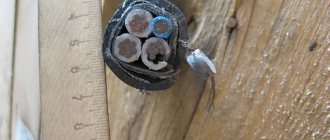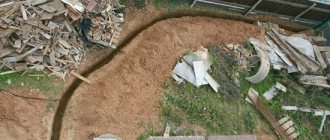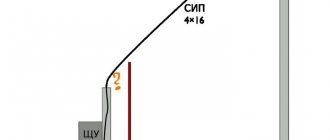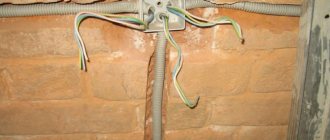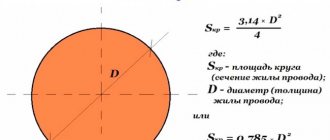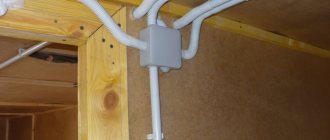When installing an electrical input into a house, each of us thinks about how it is better to do it - overhead or underground?
Installation of air SIP is always much faster and several times cheaper.
However, situations arise when it is more advisable to run the power cable into the house underground.
Firstly, it is more reliable. And secondly, it does not spoil the facade of the building or the appearance of the surrounding area.
Often these two methods are combined. Initially, an input is made to a special pipe stand from a support.
And from this distribution cabinet the cable is laid in the ground and brought into the house. When the support is located not far from the building, some SIP wires are mounted directly on the facade.
But we will turn specifically to the underground input. Let's look at what difficulties you will encounter when laying cables in the ground and place special emphasis on common mistakes when performing this work, which ultimately, sooner or later, lead to failure of the cable line.
Which cable to lay
Cable installation in the ground can be done in two ways:
- without any protection (using armored KL grades)
- in pipes or special corrugation
Let's look at the first method first. Here, as a rule, a cable with tape armor is used - VBBbShv or AVBbShv.
It is not at all necessary to use armor of the type AABL, AAShV, where there is a one-piece cast protective shell made of aluminum. It could just be ribbons overlapping each other.
In this case, armor protects not so much from external influences (someone started digging where they shouldn’t), but from deformation and traction forces during soil heaving.
Mistake #1
Never bury ordinary grades of home wiring cable in the ground without protection.
The same applies to the SIP wire. It cannot be laid in the ground, even in pipes.
Select the cable cross-section according to the connected load, but not less than 10mm2 for copper or 16mm2 for aluminum.
You can often find videos on YouTube where copper CLs with 6mm2 conductors or 10mm2 aluminum are used. This is explained by the supposedly small number of electrical appliances in the house or country house.
In terms of load, this may be enough for you, but in terms of compliance with the requirements for the minimum cross-section of the PEN conductor, you will have a violation. For single-phase power supply, the cable must be three-wire, for three-phase power supply, it must be five-wire.
How to enter the house?
There are several ways in which underground cables can be introduced into a building. At the same time, it is unacceptable to simply carry them through the foundation. There are several methods:
If the house has a basement on a strip foundation, it is necessary to make a hole into which a piece of metal pipe will be walled up. In this case, the edges of the pipe should protrude slightly above the level of the foundation. Cables will be routed into this pipe, and the remaining space must be sealed. Installation of a curved metal pipe through which the cables will be routed. This must be done in the place where the underground cable approaches the house. At the required height, lead the wires into the house through the wall
Particular attention should be paid to the bend radius - bends at an angle of 90 degrees are unacceptable. In the case of a pile foundation, this process is greatly simplified. So, the trench should be pulled to the entry point, and a small hole needs to be made in the floor of the house, through which the supply line will be inserted. With a shallow foundation, you will need to run a route underneath it
To do this, lay a metal pipe in which the cable will be laid.
Laying a cable underground is a very responsible and difficult task, in which it is important to pay attention to many little details, without damaging the insulation, since in this case the whole process will have to be redone from scratch
Digging a trench for cables - distances and dimensions
The selected cable should be carefully laid in the trench. What size should it be, what distances should be maintained when excavating it?
Mistake #2
Firstly, this trench cannot be dug close to the foundation of the house.
It is necessary to maintain a certain distance of 60cm.
After laying in the ground, the cable should not fall on the line of action of the foundation force, directed at 45 degrees from the base.
Standardized clearances from plants and trees on your site are also required. Here are the minimum dimensions for underground cable laying from nearby utilities, structures and obstacles.
What dimensions should this trench have? Here you can focus on the standard project A5-92 “Laying cables with voltage up to 35 kV in trenches” -.
The cable depth is 0.7 m. Please note that this is the distance from the surface to the top of the cable itself.
Mistake #3
Taking into account the fact that there will be a sand cushion of 10-15 cm underneath, the total depth of the trench should be at least 900 mm.
Not 0.8m, as many recommend, but 90cm, and certainly not 0.7m.
Where did all these numbers even come from? Why can’t you just bury the cable in your yard to the depth of a spade bayonet? Why such torment?
You are not doing the installation in a public place on a city street or at a construction site where heavy vehicles will drive.
The most important reason for such a depth is to ensure optimal temperature conditions for the cable.
By laying it as close to the surface of the earth as possible, you will lose the main advantage of underground installation - the lack of influence of ambient temperature and weather conditions.
The upper layers of the soil warm up much more, and moisture after good rains simply will not reach the cable sheath if it lies at 70 cm. The same cannot be said about 30-40cm.
The second aspect of such a depth of laying is pressure. The deeper the cable lies, the more evenly the pressure from above is distributed on it.
Especially under external influences - a car driving along the KL highway, something heavy was placed on top, etc.
Mistake #4
If your entrance to the house runs from a support across the road, then here you need to bury the cable to an even greater depth - 1000 mm.
The minimum trench width is calculated by the formula = cable diameter + 100mm on each side for a sand bed.
By the way, so that such labor-intensive work on digging a trench does not go to waste, some additionally lay a grounding loop in it. Just don’t forget about the minimum margins of 300-350mm.
Well, in the case of protecting the cable with a pipe, the circuit is not a hindrance at all. After all, it is not necessary that it be in the shape of a triangle or square.
And if the geometry of the site and the location of the input allow, the same trench is adapted for simultaneous installation:
- input cable
- cable to video intercom
- street lighting
- power supply for sliding gate automation
Methods for laying a line under the road surface
When connecting a site, say a dacha, to electricity, it sometimes happens that the supports with electric lines are located on the opposite side of the road. How to bring electricity into the house in this case? Let's start with the fact that you do not have the right to unauthorizedly lay a line under the road; this must be agreed upon with the administration of the city or village or other responsible body.
The first option for laying a cable line under the road is simple and does not require destruction of the asphalt. It is called trenchless installation, puncture method or HDD method. Stands for “horizontal directional drilling”. The technology is that the soil under the road is drilled with special installations, thus avoiding opening the asphalt surface. It is used for laying communications under railways, under reservoirs, under buildings.
The second option is simpler, but leads to certain destruction. You need to dig a trench by removing the top layer of asphalt.
According to PUE standards, the depth of the trench must be at least 1 m, and the cable must be located in a protective pipe.
Finally, we recommend watching a video that shows how to lay a cable under the road yourself:
Backfilling the trench with sand
Mistake #5
The bottom layer of the trench must be filled with sand; do not skip this step.
Otherwise, sharp pebbles and other foreign elements in the ground will damage the insulation after some time.
Mistake #6
The sand must be compacted. Do not lay the cable on a loose base.
What to do if you don’t have sand in stock and don’t want to order it? In this case, sift the excavated soil.
The fraction of individual elements after sifting should be no more than 5 mm.
Is it possible to do without this sand pillow or its equivalent? Why is it even needed? No you can not.
In addition to protecting the insulation from sharp objects, it plays another important role. The layer of sand under and above the cable is practically not subject to heaving.
It can be easily compacted, as a result of which there is no subsidence of the soil in the trench. No drawdown - no voids.
Namely, they lead to local overheating of the cable. The result is a situation where, in the place where a shallow hole is formed, the cable heats up significantly more than in the same area, but a couple of meters away.
Due to the temperature difference, the cable begins to “pull”. Under significant loads, the PVC insulation bursts and subsequently begins to actively suck moisture through these microcracks.
Well, don’t forget about the drainage properties of sand. Even if water reaches a depth of 0.7 m, it will pass through the sand without stopping near the cable line itself.
Correct cable routing
The cable itself is laid in a “snake” trench.
SNiP 3.05.06-85 stipulates that cables in trenches should be laid with a margin of 1-2%. This reserve is precisely provided by the snake.
Just don't go overboard with the bends.
Mistake #7
But making a reserve in the form of rings is not allowed.
Why are these extra bends needed at all? As it turns out, not for emergency repairs at all. If the CL is laid in a perfectly flat straight line, then the temperature deformations that accompany the operation of the CL will sooner or later damage the input.
Mistake #8
Before and after installation, do not forget to test the insulation of the cable cores with a megometer.
Read how to do this correctly in a separate article.
A small layer of sand is again poured on top of the laid cable.
Safety precautions and sequence of actions
How to lay a cable underground and avoid unpleasant situations and accidents during its operation, it is recommended to carry out the installation process in the sequence given below.
1. It is necessary to outline the location of the future cable laying, taking into account the following rules:
- The distance from a large tree to the cable is more than 1000 mm.
- The distance from the cable to the foundation of any building is 600-800 mm.
- You cannot lay the cable in places where increased load on the ground is expected (for example, a parking lot, road, arable land, future construction site). Places like this need to be avoided.
- Intersections of the route with another utility network or another cable must be excluded.
- When placing two parallel cables, a distance of 10 cm should be maintained. When cables intersect, they should be located at a distance of more than 15 cm from each other and should be protected with cases 2 m long.
- The armored cable must be laid, making sure to ground the armor.
2. Preparing the trench. It is most convenient to equip a special communication channel that can be opened at any time and eliminate a possible problem. If this is not possible, then dig a trench 80-90 cm deep and clear it of various stones, fragments, bricks and other objects that could damage the cable sheath.
3. Backfilling the sand cushion. The thickness of the sand cushion is about 10-15 cm. It is quite difficult to fill the trench evenly along the entire length, but the thickness of the sand should not be less than 5 cm. Sand for the cushion should be used the most ordinary, quarry sand.
4. Cable preparation. It should start with a careful check of the outer sheath of the cable. If defects are found, they should be eliminated immediately. Next, using an ohmmeter or a conventional tester, a short circuit between the conductors and the armor is checked.
Important! The cable must initially be solid. It cannot consist of two or more pieces
If, after all, it is not solid, then the connections must be made in above-ground junction boxes.
5. Cable protection. There is no strict rule for laying cables in a trench only in a protective pipe. There is a recommendation to protect the cable with a case in those places where it is necessary. But it is best to use additional protection in the form of HDPE corrugated hose. Cases and pipes are placed on top of it, which should be installed at the intersection of the route with paths and roads, various communications, where contact with a large tree or concrete slab is possible, and where the depth of the trench does not reach 50 cm.
6. Laying the cable in the trench. The main condition is to never put the cable in tension and use the following knowledge on how to lay the cable freely underground. The cases are placed in the designated places, and if an additional case is needed somewhere, it can be made from asbestos-cement pipes, cut lengthwise and laid in the required place, putting it on the cable.
7. Layout plan. At this stage, it is necessary to draw up and draw to scale an exact plan for the location of the route with all measured distances: from cable exits and trench turns to a pole, corner of a building or large tree. It would be a good idea to mark it on the wall of the building where the cable enters the ground.
8. Backfilling with sand. At least 10 cm. If the cable protrudes, it can be fixed with a wooden peg and then sprinkled.
9. Backfilling with soil. Thickness 15 cm. The soil should be free of large solid objects. You can compact it with your feet.
10. Laying warning tape. You need to make sure that the middle of the tape goes exactly above the cable. You should also check for a warning label along the entire length of the tape. The tape is used instead of the traditionally used brick protection.
11. Final backfilling with soil. The soil will settle over time, so it is better to pour more of it right away.
12. Final check of cable insulation resistance. Now you also need to check for a short circuit between the cable and ground. It is necessary to do all the work from the very beginning, if any is discovered.
Laying warning tape or bricks
To protect against a person with a shovel, as well as to mark the route, signal tape is used.
Mistake #9
Make no mistake, it should be laid at a distance of 250mm from the cable line itself, and not from the surface of the earth.
That is, when excavating, you must first hit the tape with the bayonet of a shovel, but not reach the shell. When mechanized trench digging, after detection of the warning tape, only manual excavation of the soil is allowed.
If you don’t have tape, use any available materials at home in the country.
The main thing is to lay something that will warn and “scream” - there’s a cable underneath me! Don't dig!
It is also recommended to protect the cable with bricks or asbestos-cement slabs.
Mistake #10
They must protrude at least 50mm beyond the boundary of the cable sheath in cross section.
By the way, the same applies to the tape.
Especially if several cables lie in one trench at the same time.
Mistake #11
You can’t just lay one narrow strip in the middle.
It should protrude beyond the outermost cable in the row. One is missing, use two, three, etc.
Bricks should be used as protection when it comes to the input from a substation or transformer substation to a multi-storey building, factory or other large facility.
Mistake #12
In this case, it is prohibited to use silicate or perforated bricks.
In private construction, with underground entry into a small cottage, no one will complicate their life and increase the cost of repairs by laying red bricks. Therefore, in our case, one tape will be enough.
List and order of work
There are a number of rules for laying cables on the site. First of all, you need to make a plan for the trenches on the site. The paths along which the wires will be laid must be located at a distance of at least 1.5 m from large bushes and trees. If it is not possible to bypass such obstacles in an arc, a metal pipe should be laid in the problem area. HDPE can also be used to lay cables in the ground. It is worth avoiding areas subject to increased stress, incl. parking places for a car, access for a sewage truck, etc.
If it is not possible to go around such areas, special protective cases should be used. When planning to lay the cable in trenches, it must be taken into account that it must be located at least 60 cm from the foundation.
When digging a ditch, the depth of the trench must comply with the standards. The recommended laying depth is 70 cm. If necessary, the laying depth can be reduced. The width of the trench for laying is about 20-30 cm.
When the question arises of how to lay a cable underground over a large area, more technologically advanced methods of digging a trench can be used, because using a shovel in this case is extremely labor-intensive. In this case, trenchless cable installation may be recommended. This method uses a special mechanism that pulls the wire in a protective pipe underground without the need to form a trench.
Perfectly buried cable
After all the above work, you finally fill the trench with earth. To summarize the above, we can derive the formula for a perfectly buried cable. Here's what we get:
- trench depth 900mm
- sand cushion at the bottom 100-150mm
- the cable itself
- sand cushion over cable 100-150mm
- Red brick
- soil layer 200-250mm without coarse rocks
- warning tape
- residual soil layer
Each layer after laying is compacted manually or mechanically.
As a result, you get a technologically correct and “permanently” laid cable.
Laying cables in the ground in pipes
All of the above concerns the laying of armored cables. However, due to their high cost, the method most often used is to lay the usual marks in the ground without any armor VVG, AVVG and the like.
Here protection in the form of pipes is used:
- metal
- HDPE
- double-wall corrugated (DKC 121950 or Promsleeve)
The latter can contain both electrical cables and network and telecommunication cables.
Mistake #13
Polypropylene and sewer pipes are strictly prohibited, as well as metal hoses.
For 0.4 kV power cables, a red or black corrugated pipe is used. For low current – blue.
Such corrugation in its properties is much better than asbestos pipes, which were widely used previously.
Pipes are divided according to the degree of compression resistance. And they are able to withstand pressures of several hundred kN.
By wearing special rubber seals, sections of such corrugated tubes can be connected to each other with couplings.
Connection protection degree – IP67!
The cable fill factor in the pipe and corrugation should be 1.4. What does this mean?
Mistake #14
The diameter of the corrugation or pipe should be such that the cable in it occupies no more than 40% of the total space.
Please note that not all HDPE pipes are equally useful for underground installation of cable lines. The vast majority of them are pipes for cold water supply with an operating temperature of up to 40C.
And some cables in normal modes at maximum loads heat up to 90C! Here are the corresponding letters and documents about the ban on HDPE pipes from Rosseti and Rosstandart.
Letters on the use of HDPE pipes
True, this applies primarily to high-voltage cable lines, so for your private house, in principle, little changes, you can use it.
In what cases are pipes still used? For example, in those when it is not physically possible to meet certain requirements and standards for minimum distances:
- when laying in close proximity to or through trees
- approaching or crossing with pipelines or other electrical networks
In such cramped conditions, a reduction in distance is allowed, but with the obligatory use of pipes. They protect:
- from mechanical influences and shocks
- from stray currents
- from aggressive soils
- from rodents
If the route is long (tens of meters), it is best to tighten the cable into the pipe using a special broach with a cable stocking.
And to put this broach inside, use a vacuum cleaner and a strong rope. The rope will be more fun to tighten if you attach a piece of cork or a plastic bag to its end.
Mistake #15
When joining metal sections of pipe, do not use welding under any circumstances if the cable is already pulled inside.
In this case, it is better to use threaded connections, or tighten the input into an initially straight section, and then bend it with a pipe bender.
Selecting an electrical cable for underground wiring
In underground wiring, types of armored cables are used - VB 6ShV, as well as VB6ShVng, these products have steel protection. This option is resistant to mechanical damage and will prevent rodents from damaging the wiring. With such protection, the cable will last for many years. The armored cable is laid without a pipeline, but the use of a pipe is recommended to avoid damage to the wiring by government employees. organizations in the process of carrying out work. The electrical wire for laying in the ground should be selected taking into account the required power of the facility's consumers. For example:
- The VBShvng 4x6 cable is designed for a power of 11 kW;
- The VBShvng 4x10 cable is designed for a power of 15 kW;
- The VBShvng 4x16 cable is designed for a power of 21 kW.


